
The Natural Georgia Series: The Okefenokee Swamp

 |
The Natural Georgia Series: The Okefenokee Swamp |
 |
Everybody likes to hold a record, and Georgians can claim one that should last for-ever-the largest swamp in North America, the Okefenokee Swamp, the place the Seminoles called "land of trembling earth." Where did it come from? Why is it still here? And what is the ecopersonality of this biggest of big swamps?
The Okefenokee Swamp belongs to Georgia, not Florida, although a bit of definable
swamp considered Okefenokee skirts along the northern border of the Sunshine
State. Because wetlands ecologists, geologists, and other professionals cannot
always agree on what constitutes the precise margins of a big swamp, estimates
of the acreage of the Okefenokee wilderness vary. But most agree on a figure
of approximately 700 square miles. Whatever the exact size, the majority of
the swamp lies near the eastern corner of Georgia, and most of the ecosystem
has been officially protected since 1937 when the Okefenokee National Wildlife
Refuge was established by President Roosevelt. The swamp received an additional
form of protection in 1974 when a portion was designated as part of the National
Wilderness Preservation System. 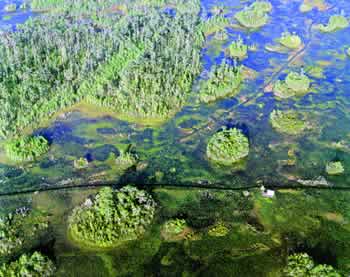
A swamp the size of the Okefenokee is more than cypress trees, dark pools, and spooky waterways. The habitats of the Okefenokee Swamp also include floating islands, or hammocks, covered with shrubs or trees, open grassland-looking prairies, and both large and small mats of floating peat, the decayed remains of long-dead vegetation, some that will support the weight of a person and some that will not.
The proclamation to recognize the Okefenokee as an environmental prize worth saving came after a quarter-century of heavy logging, beginning in 1910, in which thousands of cypress, pine, red bay and other trees were removed from the swamp. Some of the ring counts on cypress stumps showed many of them to be 400 to 900 years old. Most of the older, larger trees were removed, and many of the areas where cypress forests were virtually eliminated have been replaced by blackgum and bay trees. Nonetheless, the swamp still contains many of its original plant species — they are younger, but still vibrant and growing.
The most sizable portions of the swamp are in Charlton and Ware counties with
extensions into Brantley and Clinch counties. The long axis runs north-south
roughly 40 miles, extending from a few miles south of Waycross, almost to Moniac.
From east to west the swamp is more than 20 miles wide for most of its length.
Fifteen miles of blacktop highway from Fargo to Stephen C. Foster State Park
is the furthest any road goes into the swamp. The absence of roads maintains
the integrity of the swamp ecosystem. Today, approximately 80 percent of the
swamp is federally protected as the Okefenokee National Wildlife Refuge and
Wilderness Area, under jurisdiction of the U.S. Fish and Wildlife Service. 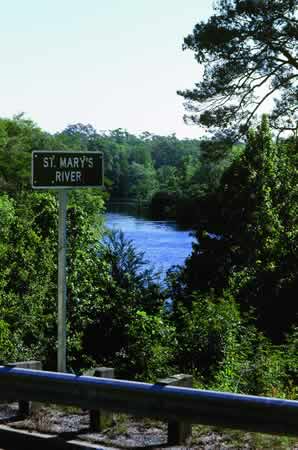
The watershed from which the swamp receives most of its water is more than 1,400 square miles. Rainfall contributes most of the water that enters the swamp, falling on the swamp itself or on the hundreds of square miles of uplands that make up the watershed. The average annual precipitation of approximately 50 inches falls mostly as rain, with occasional sleet or snow during cold winters. Surface springs may provide minor contributions to the water levels in the swamp but the amounts are negligible when contrasted with rainfall in the swamp and surrounding watershed. Typically, the majority of rain falls during the summer months followed by a relatively dry period in autumn and early winter. The remainder is distributed throughout the winter and spring.
Two rivers have their headwaters in the Okefenokee: the Suwannee and the St. Mary's. The water leaving the swamp ends up primarily along Florida's Gulf Coast via the Suwannee River. Approximately 85 percent of the water draining from the Okefenokee Swamp is carried by the Suwannee, which0 flows from the western edge of the swamp, past Fargo and into Florida. Most of the remaining water exiting the swamp eventually enters the St. Mary's River, ending up along Florida's Atlantic Coast.
Water depths in the swamp itself are characteristically shallow, seldom being greater than nine feet and averaging around two. Okefenokee Swamp water is clear but stained the color of iced tea by tannins and other products of decaying vegetation. The water throughout the swamp is highly acidic, with an average pH value of 3.7 (a neutral pH is 7, with higher values denoting more alkaline conditions). Where the Suwannee and the north prong of the St. Mary's Rivers exit the swamp, their waters are acidic as in the swamp. However, they soon flow over calcareous limestone deposits, and within a hundred miles the water chemistry of the rivers is nearly neutral.
Before heading south, most of the water leaving the swamp travels west instead
of east because of the natural barrier created by Trail Ridge. The high ridge
of sand, which forms the eastern edge of the Okefenokee Swamp, is presumably
a remnant of marine sediments deposited during the Pleistocene, which began
2 million years ago. In fact, the Coastal Plain of southern Georgia, which encompasses
the Okefenokee, is covered with sandy, nutrient-poor soils that were once beneath
a Pleistocene sea. Below the sands, at depths ranging from 30 to 110 feet, are
sands and gravels from the Pliocene epoch, 6 million years ago. 
Great waterways are not the only way water leaves a swamp. Evapotranspiration, the combined loss of water from evaporation and transpiration (the process whereby living plants release water from their leaves), can have a significant effect on a swamp's hydrological regime, the cycles of drying and saturation. Evapotranspiration is greatly reduced in winter and early spring due to cooler temperatures and decreased metabolic activity of the plant life. Consequently, in many years more than half the water leaving by the river systems does so during this period. During the rainy summer period, a major portion of the water added to the swamp is returned to the atmosphere by evapotranspiration. The Okefenokee is a hydrologically controlled ecosystem whose very character would be influenced by a change in the patterns of water flow and quality.
Of course, some might argue that the hydrology of the swamp has already been altered by humans in three significant ways. In the 1890s, 21 miles were dredged to form the Suwannee Canal in efforts to drain the swamp. The removal of the big cypress and other trees in the first third of the century undoubtedly affected the transpiration rates in the swamp. And the most recent human impact, the development of the Suwannee River Sill in 1960, has raised water levels appreciably, up to several inches, in some parts of the Okefenokee system. The combined influence of these modifications, despite the dredging in the last century, has been to maintain the swamp as a wetter place for longer periods than were normal.
Changes in water levels and retention have profoundly affected fire, which has played a commanding role in determining the environmental nature of the Okefenokee. Reduced summer rainfall presumably accounted for droughts occurring historically at 20- to 30-year intervals (1840, 1860, 1884, 1908, 1932, and 1954). Associated with the most severe droughts were wide-ranging fires that ravaged the swamp. But the seeming destruction was only in human eyes. Without wildfires the Okefenokee Swamp as we know it would cease to exist.
Fire in the swamp retards succession, which is the natural process of vegetative change and forestation that occurs in a habitat. Thus, without the natural occurrence of wildfires, the gradual buildup of peat would eventually lead to the development of a shrub habitat and then to forestation by hardwoods. However, dry peat is combustible and is prime fuel for a forest fire during the naturally occurring periods of drought. A well-placed lightning strike in a dry year could light a fire that might cover hundreds of square miles and last for weeks as the peat can smoulder and flare up days later.
Fire is a natural event in this region of southern Georgia and to control it artificially in one year means more fuel is present to be burned the next. Fire retardation by humans has provided many examples of the folly of trying to control some natural events.
Powder-dry peat can accumulate several feet deep. When it burns away in some areas, open lakes remain. When the prairies burn, invading shrubs and hardwoods are killed back, leaving the habitat open. Some trees, such as the large cypress, are fire-tolerant, but the smaller hardwoods invading the habitat beneath the canopy are killed, leaving the classic cypress stands. Such events are natural. Fire, thus, maintains the swamp as a habitat mosaic of open and canopied habitats.
Like the rest of southern Georgia, the climate of the Okefenokee Swamp is considered to be subtropical, with winters ranging from mild to ones inflicting temporary periods of bitter cold. Summers are dependably hot every year, but autumns and early spring are generally what anyone would call pleasant.
No matter what the physical and chemical features of the habitats, no matter what its geomorphological features, the status of a region's biodiversity speaks to its environmental health. The native species that remain in a habitat at sustainable levels offer a positive message. The species that once lived in an area but are now missing bring the sad news. For many habitats in Georgia and the rest of the United States, the bad news overrides the good. Few places in the country have biodiversity news as good as the wetlands, waterways, trembling layers of floating peat, islands, uplands, and freshwater prairies of the Okefenokee Swamp.
Ivory-billed woodpeckers, Carolina parakeets, and passenger pigeons are gone, to be sure, but they represent the nation's loss, not just the Okefenokee's. Panthers, and probably gray wolves, also once roamed the swamp, and to lament their loss would be understandable, not only for the Okefenokee but for most of the eastern half of the nation.
With the bad news aside, one can now look to the positive, the truly good news that the most majestic swamp in America is in good environmental health. Biodiversity is the vital sign symptomatic of its condition. Pick a group of flora or fauna-birds, wildflowers, frogs, aquatic plants-and one can find in the Okefenokee almost all of what one is supposed to find in an enormous southern swamp that has been protected for decades from the environmental assaults that accompany what some call progress. In fact, talk persists that panthers may even be reintroduced to the Okefenokee Swamp by the U.S. Fish and Wildlife Service, from the remnant population of panthers left in southern Florida.
Every creature and plant in the Okefenokee must have mechanisms to adapt to the singular environmental conditions. The variety of approaches used by certain plants bespeaks the low nitrogen and phosphorous content in the soil and waters of the Okefenokee. Plants must compensate for the low availability of these vital nutrients, and one group has found a way that always works when insects are around. Carnivorous plants that lure, ensnare, and ultimately digest animals are found in many regions of the world, especially in habitats like the Okefenokee that are highly acidic and low in nutrients.
Among the different kinds of carnivorous plants indigenous to the Okefenokee, the luring and capture of prey is accomplished in a variety of ways. Pitcher plants are the most obvious and best known. Although different species vary in shape, size, and color, each makes use of pitfall traps, vertical tubes with wide tops that offer an entrance for insects. But inside the lip of the upturned flask, downward-pointing hairs assure there will be no exit for the careless bug. In some pitcher plants, which grow in colorful clusters of yellows, greens, and browns, the tube may be only a few inches high, whereas in others the insect-trapping pitchers may be the length of a yardstick. At the bottom of each pitcher plant flask floats a liquid pool of enzymes that digest the luckless insect that has come over the top on a journey of no return. Following digestion, the insect's nitrogen and phosphorous are absorbed by the plant.
Most people will notice the array of pitcher plants, but inexperienced visitors may overlook some of the other carnivorous plants. Sundews and butterworts are small, harmless-looking plants that capture insect prey with a sticky surface film that acts like glue. Upon landing on the leaves, an insect finds itself stuck to the plant. As if being stuck on the plant were not bad enough, the insect eventually ends up inside the plant, for digestion takes place on the leaf's surface. The tiny sundew plants even have tendrils that slowly close around the insect, assuring that it remains a captive until digestion is complete.
To tiny aquatic invertebrates, bladderworts are among the most treacherous of the carnivorous plants. The small white or yellow flowers of the floating plants are obvious on the surface of many quiet pools. Yet beneath the surface the drama qualifies as one of the most marvelous feats of prey capture by any plant. The slender bladderwort branches float at the water's surface, each equipped with hundreds of tiny air-filled devices called bladders. Each is a trap for any small, aquatic creature that unwittingly brushes against one of the hair triggers on the bladder's surface. When this happens, a tiny door snaps inward, instantly sucking the defenseless victim inside. When the prey is inside the bladder chamber, now filled with water, the door slams shut. The entire sequence is accomplished in about one four-hundredth of a second, whereupon digestion begins. Bladder traps are no larger than a raindrop, so the primary prey of bladderworts are very small insects, such as mosquito larvae and zooplankton.
The significance of the carnivorous plants in this fantasyland aspect of the ecosystem is their adaptation to living in an environment that is nutrient poor by most standards. Yet these plants have managed to survive by gathering the required nutrients from sources that are mobile and therefore capable of gathering precious resources from a variety of places.
One identifiable feature of the swamp ecosystem is the diversity of habitat types: open lakes, prairies, cypress stands, shrub swamps, blackgum forests, and bay forests. Among the distinctive habitat types in the Okefenokee are the tree islands, floating mats of peat that support various mixtures of shrubs, hardwoods, and cypress. Approximately 70 tree islands scattered throughout constitute roughly one-tenth of the swamp. About one-fifth of the swamp is recognizable as prairies. The drier, but still soggy, prairies are mostly grasses and sedges, with patches of sphagnum moss, ferns, and rushes. The shallow, wet prairies are dominated by vast areas of flat-leaved, floating plants such as white and yellow water lilies and floating hearts. Emergent plants, such as pickerel weed, yellow-eyed grass, and golden club intersperse among the floating plants.
About a third of the swamp is shrub swamps, with evergreen, leathery leaved shrubs such as fetterbush and dahoon holly dominating the landscape, along with pepperbush, a deciduous shrub. A few blackgum forests persist in some areas, characterized by the presence of occasional pond cypress as a canopy tree with red maple and dahoon holly, which can grow into a small tree, filling in the understory. A comparable portion of the swamp is recognizable as bay forests, with broad-leaved, evergreen loblolly bays, red bays, and sweet bays being the dominant trees.
Cypress forests, many people's stereotype of a swamp, make up about a fourth of the Okefenokee. Many of the habitats originally classified as cypress forest were heavily lumbered in the early part of the century and have now been replaced by blackgum or bay forests. These species are frequently understory trees in cypress swamps and, upon removal of the towering cypress, established themselves as the dominant vegetation. However, a few pure stands of cypress remain in the Okefenokee, somehow spared from the early logging efforts. Combinations of the definable habitats and associated species create an environmental medley that contributes further to the diversity.
The Okefenokee Swamp has its share and more of vertebrates, with more than 400 species being known from the area, of which more than half are birds. Practically every species of southeastern wading bird and waterfowl visits or is a permanent resident in the Okefenokee. Included are the big ones, such as the federally endangered wood stork, imposing great blue heron, and trumpeting sandhill crane. Long strings of white ibises, with their red faces and curved bills, are commonly seen soaring above the treetops, coming or going from one of the many rookeries.
Many birds are seasonal in their appearance. The ducks, buffleheads, and blue-winged
teals are winter visitors, whereas the colorful purple gallinule and least bittern
are present most commonly during warmer months. The Okefenokee Swamp is the
year-round home of many bird species, such as the wood duck, in which males
sport a multicolored breeding plumage. Another is the sandhill crane whose seven-foot
wingspread and bugling in flight provide one of the most magnificent spectacles
of sight and sound to be found among native wildlife. In spring and autumn,
a variety of migratory birds stop over in the swamp on their way to or from
tropical America or southern Florida. Collectively, the bird life brings the
swamp alive year-round with its diversity of sounds and visual displays. 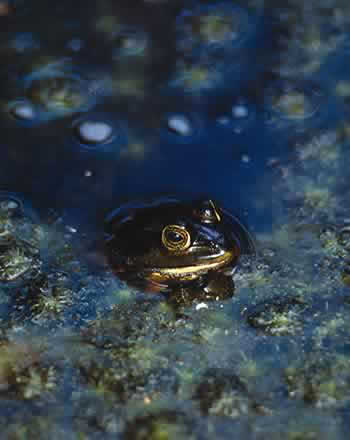
While the birds provide the daytime music, the frogs keep nighttime in the Okefenokee alive with sound. More than 20 species of frogs and toads inhabit the great swamp. Each makes a unique sound characteristic of the particular species. We need not go to the tropics or other exotic regions to experience a wide diversity of calls from the frog world. Almost everyone knows what a bullfrog looks like and has some idea what it sounds like, a bass drum set to music. But the pig frog, almost indistinguishable superficially from the bullfrog in both size and appearance, holds the franchise in the Okefenokee. Its grunt-like mating call is unmistakably different from its close relative, but not much different from a hog. The snorting of pig frogs can be heard from aquatic habitats throughout the swamp during much of the year. Another Okefenokee frog, closely related to pig frogs and bullfrogs, is the river frog. Its deep snoring would never be confused with the other two.
The call of the male leopard frogs, which are common amphibians throughout the swamp, is variously described as chuckles or the sound a balloon makes when you squeeze it. The bronze frog, or green frog, which looks like a small bullfrog, has a call that is usually just one loud note, sounding like a single pluck of a banjo.
The calls of the toads found in the Okefenokee Swamp are as varied as those of the frogs. The word "toad" conjures up an image of a squat, brown, warty-looking creature, yet the calling males of some species make beautiful music. The southern toad gives a pleasant musical call, a melodic trill often heard from the Okefenokee wetlands on warm rainy evenings of spring and summer, belying the appearance of the caller. The bleating of the narrow-mouthed toad sounds not unlike a sheep, and the harsh din created by hundreds of eastern spadefoot toads calling after a downpour creates an unnerving sound in a dark swamp.
Ten members of the treefrog family live in the Okefenokee Swamp, including
the green tree frog, or cowbell frog, which makes a honking sound familiar to
anyone who visits southern lakes or ponds in warm weather. The barking tree
frog, when in large choruses, can sound like a distant dog pack, another of
the many night sounds of the swamp that can make a visit memorable. 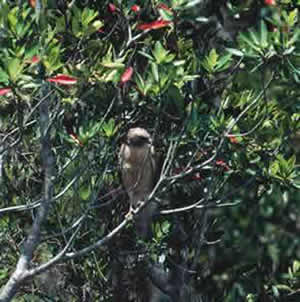
Some species of frogs found in the Okefenokee breed and make their mating calls in the colder months of the year. On any rainy winter night, especially one that is not too cold, one can hear chorus frogs around small wetlands. The southern chorus frog sounds like someone running a thumb over a comb. The ornate chorus frog's call sounds like a metallic peep. The most familiar of the chorus frogs is the spring peeper, which gives its peeping call in early spring in the North, but in the Okefenokee should be called the winter peeper.
Although frogs can be heard in every month of the year in the Okefenokee Swamp, late spring and summer are when the frog orchestras really tune up. As many as a dozen different species can be heard on rainy summer nights around the undisturbed wetlands. One of the exciting features of being in a region with a rich biodiversity of birds and frogs is not only what you might see but what you might hear.
But the Okefenokee is full of animal wildlife that you almost never hear and seldom see. Sixteen different kinds of salamanders populate the swamp system. Included are the two permanently aquatic giant salamanders that resemble eels. One is the amphiuma, sometimes called the Congo eel, with four tiny legs; the other is the greater siren, which lacks hind limbs but has two front legs behind a pair of feathery gills. Both reach maximum lengths of more than 3.5 feet, making them the longest salamanders known from the Western Hemisphere.
Most of the amphibians of the Okefenokee, both frogs and salamanders, are dependent on the fluctuating wetlands for egg laying and larval development. Fish are often absent, at least part of the time, from wetland pools that fill and dry, an important consideration for small, soft-bodied creatures that would make an easy meal. Two of the salamander species that occur in the swamp, the flatwoods salamander and the striped newt, are of special concern to One conservationists because of their disappearance in many parts of their geographic ranges. The Okefenokee serves as a sanctuary for such animals.
Representatives of 14 different families of fishes swim in the waterways, pools, and cypress swamps. The number of fish species is not especially high relative to the other lakes and streams of the region, but the species present constitute a diverse array. At least 36 species of freshwater fishes have been reported from the swamp, including the Florida gar, American eel, and the Okefenokee pygmy sunfish that seldom reaches a length of more than an inch and a quarter. The large, primitive bowfins, which are represented by more species in the fossil record than occur today, live in the clear, vegetated waters alongside the smaller redfin and chain pickerels. Five species of catfishes can be found in the swamp as can nearly a dozen members of the sunfish family. Like all animals and plants in the Okefenokee, the fishes inhabit a special environment by today's standards, a healthy natural habitat that is destined to remain so, as far as human interference goes, as a result of the vigorous standards of environmental protection.
A select few of the more than 60 species of reptiles native to the Okefenokee
Swamp help establish the aura and myth associated with most southern swamplands.
American alligators and venomous snakes, of which five species exist in the
Okefenokee, set the tone. However, if the Okefenokee has a keystone species
of animal, or one that rises above the rest in stature, it is the alligator.
Alligators and other crocodilians demonstrate behavioral characteristics that
are unique among the reptiles. For example, their maternal behavior includes
nest-guarding and fierce protection of the young, and they communicate vocally
among individuals. 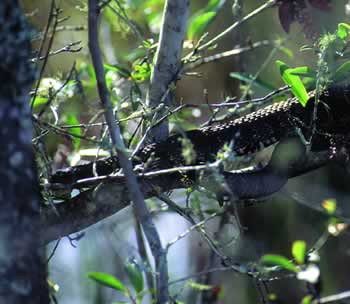
The formidable nature of alligators, with their big teeth and powerful jaw muscles, should not be underestimated. Nor should a potential swipe from the muscular tail of an adult alligator. Many people's attitude about the danger of alligators and snakes in a swamp is based more on imagination than on reality. In most instances, the opportunity for humans to experience any of the alligator's weapons firsthand will come only to those who attempt to capture one. Under natural conditions, alligators are usually shy, retiring creatures that generally mind their own business, which does not include promoting encounters with humans.
One conspicuous exception occurs. A female American alligator will often exhibit extensive and complex maternal care and protection of her nest or young. Mother alligators guard their offspring, and alligator attacks on humans are often a result of a powerful drive for the female to take care of her eggs or babies.
Threat displays by female alligators are probably the most common form of apparent aggressive behavior that most people observe. Open-mouthed displays, hissing, and even emergence onto land are common when a mother alligator feels her progeny are in danger. But aside from their extreme expression of the family value of protecting one's young, alligators ordinarily pose little or no danger to people who leave them alone. Alligators have had far more of a psychological effect on humans than a physical one.
Nearly every report of an unprovoked alligator attack on a human has proved to be equivocal as to whether the alligator was harassed or threatened in some way. Nonetheless, no risk should be taken with small children in alligator habitat, as a child might conceivably be considered small prey. And numerous documented cases confirm that alligators will pursue and eat a dog in a mammalian heartbeat. Also, a captured or restrained alligator of any size will bite a human if given opportunity. But the alligator is not to be blamed for that.
Snakes rival the alligator for inspiring swamp tales. And indeed the Okefenokee has its share of snake species with 36, more than are found in most of other states. Five of these are venomous, four of them being pit vipers and one belonging to the cobra family. In the more terrestrial habitats, three species of rattlesnakes set the mood. The pygmy rattler with its tiny string of rattles that sounds not unlike a small, buzzing insect is the smallest. The canebrake rattler, gray with black chevrons crossing the back and a tail that looks like black velvet, reaches sizes of five feet or more. And the most impressive rattlesnake of them all, anywhere, is the Eastern diamondback. Adults can approach a length of eight feet and can be as big around as a softball.
The coral snake, the small, slender, close relative of the cobra, is also found in the region but is one of the least likely snakes to be seen. And, finally, the most common of the pit vipers in wet habitats throughout the swamp is the cottonmouth. Although the venom injected by the fangs of any of the pit vipers could cause severe pain and even be lethal, the danger from snakebite in a swamp is greatly overrated. In the United States, the majority of reported bites by snakes occur as a consequence of someone picking up the snake.
None of the five venomous species found in the Okefenokee (the copperhead, which is common further north in Georgia and the Carolinas, is absent) will attack a human without provocation. Rattlesnakes and cottonmouths will stand their ground if a ready retreat is not available, but none will aggressively attack. Tales of snakes chasing people in Georgia are just that, tales. In fact, despite the rich biodiversity of snakes in the Okefenokee wetlands and surrounding uplands, their apparent abundance in the swamp itself is often lower than most people would anticipate.
Although for many people the psychological focus is on the venomous species of snakes, the 31 harmless species far outnumber the potentially dangerous ones. Some, like the water snakes, look mean and will bite if grabbed by hand. And all snakes have tiny teeth, though none compare in size to the fangs of the pit vipers.
One of the most beautiful and rare snakes of the Okefenokee Swamp is the rainbow
snake, with an iridescent black body with red stripes running the length and
brilliant yellow along the lower sides. Large specimens reach lengths greater
than 5.5 feet, and the primary diet of adults is the American eel. Another magnificent
species of snake, now federally protected as a threatened species under the
Endangered Species Act, is the indigo snake. Indigos, which reach lengths greater
than eight feet, longer than any other snake native to the United States, are
also rare finds, even in the Okefenokee. But their presence there makes a statement
about the protection offered to all wildlife. 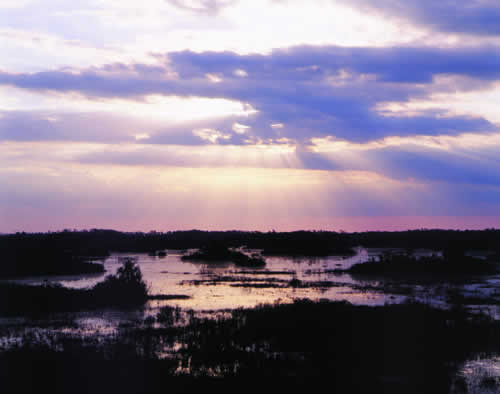
Most of the 11 species of lizards found in the Okefenokee are not particularly abundant, although the Carolina anole could be encountered, often in large numbers, wherever vegetation occurs. The anole's trait of changing from brown or gray to bright green in color has earned it the common name of "chameleon." Three of the lizard species that live mostly on the sandy, higher ground habitats are unusual in having no limbs and superficially resembling snakes. The glass lizards, as they are called, are infrequently encountered because of their underground burrowing habits.
The 14 species of turtles representing five different families make up the final group of reptiles. Included are the flat-bodied, leatherlike softshell turtles that get as big as a turkey platter. The small, dark mud and musk turtles prowl the heavily vegetated pools and waterways. In the upland habitats, the strictly terrestrial gopher tortoises dig their underground burrows, which serve as their retreats from predators and cold weather.
Altogether, about 30 species of native mammals inhabit the swamp region. Otter, mink, and beaver are characteristic of the streams and deeper water habitats of the swamp. The black bear, white-tailed deer, and bobcat are more terrestrial large mammals of the swamp. Other land mammals include the gray fox, opossum, and raccoon. The cottontail of higher ground is replaced by the marsh rabbit in the wetland habitats. The panther, however, has been gone from the Okefenokee for decades.
Despite its immensity, no plant or animal species is endemic to the Okefenokee Swamp, each being found in habitats elsewhere in the region outside the swamp. Yet more than a half century of protection has created a wildlife paradise unparalleled in the region. The natural biodiversity reflects the unspoiled habitats where the progress of human development has yielded to environmental progress, a stride every Georgian should be proud to have taken.
Read and add comments about this page
Go back to previous page. Go to Okefenokee Swamp contents page. Go to Sherpa Guides home.
[ Previous Topic | Next Topic ]